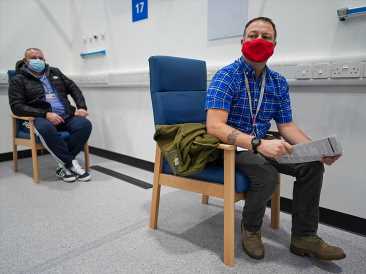Oxford-AstraZeneca (Vaxzevria) COVID-19 vaccine: Known side effects

Vaxzevria, the COVID-19 vaccine developed by the University of Oxford and AstraZeneca, may cause some of the mostly mild-to-moderate side effects that people often encounter after any vaccination. However, there are also some recent controversies surrounding rare blood clotting incidents linked to this vaccine.
The Oxford-AstraZeneca COVID-19 vaccine — also known as Vaxzevria, as of March 25, 2021 — is a two-dose vaccine jointly developed by the Oxford Vaccine Group and pharmaceutical company AstraZeneca to target the SARS-CoV-2 virus.
Serum Institute of India’s COVID-19 vaccine, called Covishield, is a version of the Oxford-AstraZeneca vaccine that manufacturers in India produce locally.
According to AstraZeneca’s primary analysis of phase 3 trial data, the vaccine has a 76% efficacy rate after both doses.
Stay informed with live updates on the current COVID-19 outbreak and visit our coronavirus hub for more advice on prevention and treatment.
On January 29, 2021, after a recommendation from the European Medicines Agency (EMA), the European Commission granted the vaccine “conditional marketing authorization” in the European Union for adults aged 18 years and older. The
This viral vector vaccine contains the gene that encodes for the spike protein on the surface of the SARS-CoV-2 virus. Once delivered to our cells, the gene is transcribed, prompting our cells to make the spike protein. The presence of this protein triggers the body’s immune system to produce antibodies to fight against the spike protein, which then prepares the body to fight against SARS-CoV-2 should it enter the body.
Note that the vaccine does not contain the SARS-CoV-2 virus itself and does not cause COVID-19.
Common side effects
According to the vaccine’s safety profile within the product information, the most common side effects include mild-to-moderate symptoms of one or more of the following:
- headache (52.6%)
- fatigue (53.1%)
- muscle or joint pain (44% or 26.4%)
- fever (33.6%)
- chills (31.9%)
- nausea (21.9%)
The percentages are based on reports from four clinical trials with a total of 23,745 participants.
Individuals also commonly reported pain and irritation at the site of the vaccine injection.
Additionally, an allergic reaction to certain ingredients in the vaccine may occur. Symptoms of an allergic reaction may include hives, a rash, swelling, and respiratory symptoms.
There have also been a few cases of anaphylaxis, which refers to a severe and potentially life threatening allergic reaction. However, anaphylaxis is a very rare event.
According to the Medicines & Healthcare products Regulatory Agency (MHRA), out of 19.5 million administered doses of Vaxzevria, only 455 (0.002%) were associated with an anaphylaxis-related adverse reaction.
People who have known allergies to any of the ingredients — the active substance itself or any ingredients listed under the product information’s “List of excipients” — are advised against receiving the vaccine.
All the side effects listed above are similar to those associated with other vaccines, as the
Controversy regarding blood clots
In early March 2021, the Danish Health Authority put vaccination with Vaxzevria on hold following reports of severe cases of blood clots.
The EMA noted that 30 cases of blood clots, or thrombosis, had occurred following Vaxzevria administration to around 5 million people in the European Economic Area. This included one fatal case in Denmark.
In particular, the EMA observed thrombosis cases alongside thrombocytopenia, which is a condition of low blood platelet counts. It also observed multiple types of thrombosis, including unusual cases of cerebral venous sinus thrombosis, which is a rare occurrence of blood clots in the brain.
The EMA’s safety assessment committee concluded on April 7, 2021, that unusual blood clots with low blood platelets should be listed as very rare side effects of Vaxzevria, suggesting a potential causal link.
However, the EMA states that the vaccine’s benefits continue to outweigh the risks by preventing SARS-CoV-2 infection.
According to the MHRA, in the United Kingdom, there had been 79 reports of blood clotting cases with low levels of platelets as of March 31. All of these cases occurred after first dose administration, and 19 were fatal.
Out of the 79 cases, 51 occurred in women, and most occurred in those below the age of 50 years. The MHRA noted, however, that a greater number of women than men had received Vaxzevria overall.
Although the regulatory agencies have not listed specific risk factors for blood clotting, the EMA suggests that the combined incidents of blood clots and low blood platelet counts may be a type of immune response.
The regulatory agencies advise that individuals and healthcare professionals alike be mindful of the symptoms of thrombosis to ensure prompt detection and treatment.
Some symptoms related to thromboembolic events include:
- shortness of breath
- chest pain
- leg swelling
- abdominal pain
- neurological symptoms, including headaches and blurred vision
- tiny blood spots beneath the skin beyond the vaccine injection site
Currently, 83 countries have authorized COVID-19 vaccinations with Vaxzevria.
For live updates on the latest developments regarding the novel coronavirus and COVID-19, click here.
Source: Read Full Article
